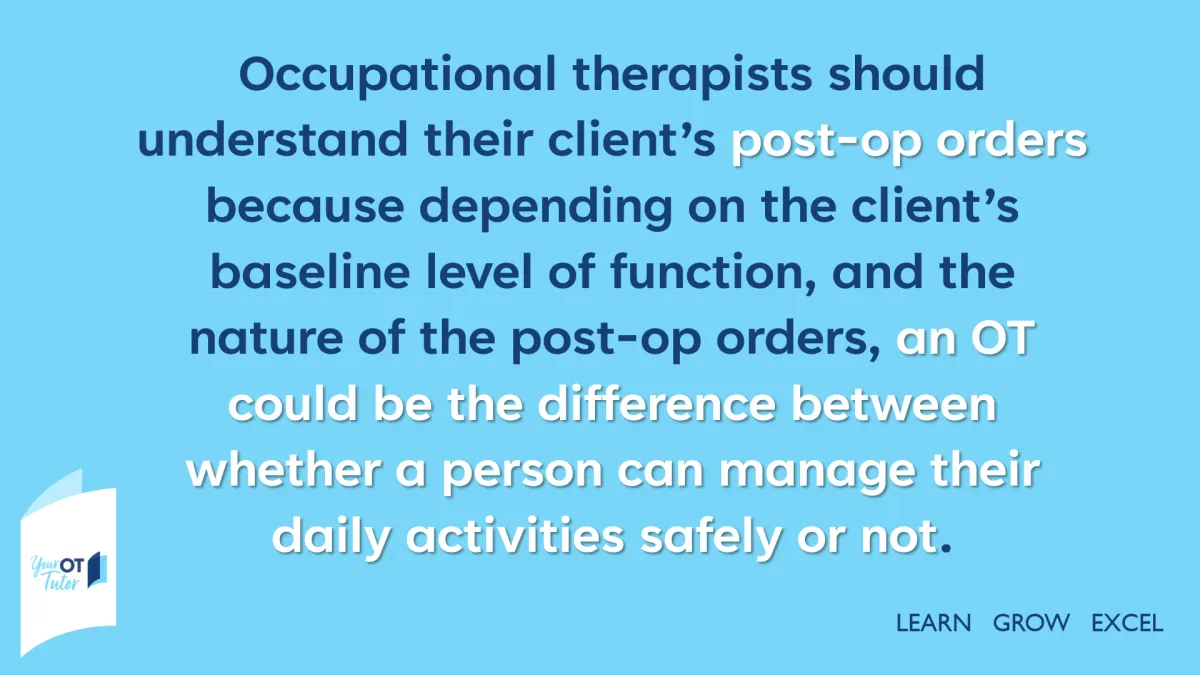THE YOUR OT TUTOR BLOG
Articles on important topics for occupational therapists...


SHOULD OCCUPATIONAL THERAPISTS READ THE POST-OP ORDERS FOR THEIR CLIENTS WHO HAVE HAD SURGERY?
It is important for OTs to read and understand post-op orders when their clients have had surgery because depending on the client’s baseline level of function, and the nature of the post-op orders, an OT could be the difference between whether a person can manage their daily activities safely or not.
OTs have the unique ability to understand how a person’s functional ability, their environment, and the requirements of the activity all interact to result in the person’s occupational performance (i.e. their ability to perform the activity). We need to have an understanding of the type of surgery that has been performed, and whether there are any restrictions that the client needs to follow, which may impact their ability to complete their daily activities. While you may think this is the domain of hospital-based OTs, it is very common for clients to be discharged while still needing to follow post-op orders, so it is something community-based OTs should be aware of too.
Here are some examples of some common post-op orders and the associated functional implications that OTs should be aware of.
Scenario 1 – Client is non-weight bearing due to a leg fracture
The patient may be independent in showering themselves in a hospital ward with a level entry shower and grabrails, but what if their shower at home is over a bath? The “just get a shower chair from the chemist” approach isn’t really going to help them here, and an OT review to suggest alternative bathroom aids such as a bathboard or transfer bench is needed to ensure the person can shower safely at home.
Scenario 2 – Client has had heart surgery
Depending on the type of surgery, it may be that the client is not allowed to weight-bear through their arms for a period of weeks post surgery to allow their sternum and ribs to heal (look up “sternal precautions” for more info). No problem if the person has good baseline mobility, but what if they already had difficulty with transfers before surgery and were dependent on pulling heavily on their left-sided grabrail to get off their toilet at home? Suddenly the basic task of toileting becomes a big challenge and safety risk, and the client may need extra assistive technology or even someone to assist them to complete this task; this needs to be considered before they are discharged home!
Scenario 3 – Client must wear a hand-splint full-time for 3-4 weeks while their fracture heals
No big deal for someone fit and well prior to their injury, but what if the client is elderly and normally needs to use a four-wheeled-walker or walking stick to mobilise safely? It’s pretty difficult to steer a four-wheeled walker with one hand! Even if their uninjured hand is the one that would normally hold a walking stick, what was once their free hand for opening doors and carrying items is now covered in a splint. This could lead the client to attempt to get around without any walking aid, which could drastically increase their falls risk if they were already unsteady at baseline. Besides the mobility implications, what if they live alone and can’t adjust the splint themselves if it gets loose or wet? In this instance a quick discharge straight from ED over the weekend may cause big problems that may only be picked up and dealt with by a community therapist.
Scenario 4 – Client has had a hip fracture
While when you hear hip fracture, you may automatically think “hip precautions” are needed, but this may not be the case. Some surgeries to fix a hip fracture involve an ORIF (Open Reduction Internal Fixation) with a femoral nail; these surgeries don’t usually require hip precautions. If a total hip replacement was required, then often (but not always) hip precautions are required. This includes restrictions such as no bending greater than 90 degrees flexion, no twisting and no adduction across the midline. These restrictions impact activities such as rolling over in bed, getting dressed and even getting off a low toilet. OTs can provide assistive technology (e.g. long-handled aids or raised toilet seats) or alternative techniques to help our clients maintain their independence during their recovery.
Scenario 5 – Client has wounds requiring dressings
While some wounds may be covered with waterproof dressings, or dressings that are changed daily with showers, often wound dressings need to be covered with a water-proof plastic whenever the person wants to have a shower. Sounds like a simple plastic bag and some tape may do the trick, but what if your client has decreased hand or arm dexterity or range of motion? What if they are already a little unsteady on their feet and now a bag on their foot will escalate their falls risk on a wet bathroom floor? OTs are able to identify these potential functional challenges and help clients to problem-solve a solution to manage their showering safely, while keeping their wound dressings dry.
So, make sure you take the time to understand any post-op orders your client may have and consider their abilities, environment, and the nature of the activity to identify any issues, then use your OT problem-solving skills to find a solution!
If you found this blog helpful, then sign-up to the Your OT Tutor mailing list to be notified when new resources, courses, and blogs are available.






